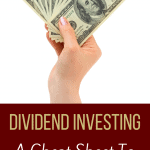THIS POST MAY CONTAIN AFFILIATE LINKS. PLEASE SEE MY DISCLOSURES. FOR MORE INFORMATION.

That’s because of the rise of discount brokerages. Discount brokerages make it cost effective to invest smaller sums of money.
Most discount brokerages allow investors to trade for under $10 a trade. Some even offer free trading:
- Robinhood offers free trades
- Loyal3 offers free trades
- Motif Investing offers “motifs” for just $9.95
These brokerages minimize the cost of investing.
As a rule of thumb, you should always keep your transaction costs under 1% of your total trade amount. For example – if your brokerage charges you $7 to trade, you should invest in chunks of $700 or more. Free brokerages allow investors to invest smaller sums of money. And just because an online broker doesn’t offer free stock trades, it doesn’t mean they aren’t worth looking at. Both Fidelity and Schwab allow you to trade some ETFs without a fee.
Table of Contents
What To Invest In – Start Dividend Investing Basics
Having the ability to invest cost effectively is important, but it doesn’t tell you what to invest in.
That’s where dividend investing comes into play. The core idea of dividend investing is that your investments should pay you (what a novel concept).
Dividend paying stocks pay out a portion of their earnings to shareholders. The greater the percentage of earnings paid out, the higher the companies payout ratio is. You can quickly see how much a dividend stock is paying by looking at its dividend yield. Dividend yield is the dividend payment per share divided by the price per share.
All things being equal, the higher the dividend yield, the better. In today’s market yield is difficult to come by. The S&P 500 currently yields 2.1%. Its historical average dividend yield is 4.4%.
Dividend yields have been falling for decades. There are a few reasons why. First, stocks in general are more expensive today than their historical averages. The S&P 500’s historical price-to-earnings ratio is 15.6. It is currently at 23.0. Second, changes in dividend taxation rules have made dividends less tax efficient than capital gains for taxable investors.
Finally, share repurchases have gained popularity over dividends in many corporations because share repurchases help to boost share prices. Many executives’ compensation packages are tied to rising share prices. Dividends don’t increase the share price because money is given directly to shareholders. Share repurchases reduce the number of shares outstanding, making the ones that remain more valuable. This makes them favored for investors.
Despite these changes, there are still many businesses that pay high dividend yields – and that increase their dividend payments over time, thus making it a good time to start dividend investing.
Reasons To Be A Dividend Investor
Dividend stocks have historically outperformed the market over long periods of time. I believe the reason they’ve done so is because dividend paying companies have the ability to:
- Generate cash consistently
- Pay it out to shareholders
This means a company’s management is looking to reward shareholders, and the business is generally profitable. There is a specific type of dividend stock that has performed especially well; stocks that pay rising dividends every year.
The Dividend Aristocrats Index is comprised of 50 businesses that have paid increasing dividends for 25 or more consecutive years. The Dividend Aristocrats Index has outperformed the market by over 3 percentage points a year over the last decade. This is excellent performance.
The Dividend Aristocrats Index is made up of some of the best and most well-known businesses in the world. Companies like:
- Coca-Cola (KO)
- Johnson & Jonson (JNJ)
- Procter & Gamble (PG)
- Colgate-Palmolive (CL)
- Wal-Mart (WMT)
- 3M (MMM)
The best reason to be a dividend investor is to generate rising passive income over time. Investing in high quality dividend growth stocks with long histories of paying rising dividends makes it very likely that your investments will pay you more every year.
Building Your Dividend Snowball
Have you heard of debt snowballs?
The idea is to line up your debts from smallest to largest and pay them off in order (smallest first). As you pay off the smaller debts, you have less interest expense and more money to throw at the larger debts. This growth in money to pay off debts ‘snowballs’ – the more debts you pay off the more money you have to pay off more debts.
Building a portfolio of dividend growth stocks is the same.
As you begin investing, your portfolio will only produce a small amount of income. You have two things working in your favor, however:
- Dividend growth stocks increase dividends over time
- The money you save over time adds up
As an example, a portfolio of $5,000 invested in stocks with a 3% dividend yield will pay you $150 in passive dividend income every year.
If the stocks you invested in grow their dividends at 6% a year (which is very reasonable – and possibly even conservative), in 10 years you will be making $269 a year from dividends… Without adding any extra money.
Now imagine if you reinvested those dividends every year into more dividend growth stocks. By the end of 10 years you’d be making $355 a year in passive income every year.
Over time, your money snowballs.
To really create a snowball effect with dividend growth stocks, you need to:
- Invest regularly
- Reinvest dividends
This will result in serious compounding effects over time. Your portfolio’s income will grow from money you are adding to it, money reinvested from dividends, and dividend raises from the dividend growth stocks in which you invested.
What Dividend Growth Stocks To Buy
There are two ways to invest in dividend growth stocks when you start dividend investing – indirectly through ETFs, or directly through individual stocks.
There are pros and cons to both methods.
ETFs give you immediate access to a diversified portfolio of dividend growth stocks. They are time effective as well. You don’t need to research different individual businesses. All you have to do is invest in the ETF and you are done. There are a multitude of dividend ETFs available. Based on my research, the best dividend ETFs are:
- First Trust Value Line Dividend Income (FVD)
- Vanguard Dividend Appreciation ETF (VIG)
- S&P 500 Dividend Aristocrats ETF (NOBL)
The downside to investing in dividend ETFs is their expense ratios. ETFs are not charities – they charge for their services. This reduces your returns as money is paid from your investments to the fund manager. You also don’t get to choose exactly what you invest in – those decisions are made by the fund manager and are based on the methodology of the ETF.
This brings us to investing in individual dividend companies.
The advantage to start dividend investing in individual stocks is you know exactly what you own. This can be helpful when trying to hold through recessions. For many people, it’s easier to hold Coca-Cola stock (or other great businesses) through a recession because you know the company will be fine in the end. Investing in ETFs is less clear – you don’t get the same connection as you would by investing in an individual business.
The second advantage to investing in individual stocks is that it is more cost effective. There are no management fees when you invest directly into individual stocks.
The downside to investing in individual stocks is it takes more time. You have to find businesses with competitive advantages that are trading at fair or better prices. You must also have confidence in these businesses to hold them through the ups and downs of the market.
The four steps below are a quick way to find high quality dividend growth stocks suitable for long-term holding. Your investments should meet all 4 of these criteria:
- Businesses you understand well (like PepsiCo or Wal-Mart)
- Stocks trading below a price-to-earnings ratio of 20 (at most), and preferably under 15
- Stocks with long histories of dividend increases every year (I prefer 25+ years)
- Stocks with dividend yields above 3%
The previously mentioned Dividend Aristocrats Index is a great place to start looking. All Dividend Aristocrats have 25+ years of consecutive dividend payments without a reduction.
Plan For Success
Start dividend investing with a plan. It is important to save and invest every month (or quarter, depending on your circumstances) regardless of if the market is up or down – as long as high quality dividend growth stocks are available at fair or better prices.
You should build your portfolio over time so that it includes 20+ names (if you are investing in individual stocks). This gives you the benefits of diversification. No one can tell the future. By spreading your investments over many great businesses, your portfolio will still be in good shape if something unexpectedly bad happens to one of your holdings.
You should also plan for and prepare yourself to withstand recessions and large stock price declines. Stocks can decline by 50% or more at any time. This happened fairly recently during the Great Recession of 2007 to 2009. It can and will happen again.
Investors who sold at the bottom of the market realized very serious losses. Investors who held their dividend growth stocks, reinvested dividends when shares were depressed, and continued buying at depressed prices did very well.
If you prepare ahead of time for stock price declines and recessions, you are more likely to be successful.
The end goal of dividend investing is to build a portfolio that pays you large and rising dividend income every year.
Whether you choose to invest in 1 or 2 individual stocks (depending on your brokerage costs), or a high quality dividend ETF, you can and should start your dividend portfolio with as little as $1,000.
What’s important is that you do start dividend investing, and that you continue adding to your portfolio over time.
Plant your dividend investing trees today, so you have a forest of dividend growth later on in life.
Author Bio: This start dividend investing contribution is from Ben Reynolds at Sure Dividend. Sure Dividend uses The 8 Rules of Dividend Investing to build high quality dividend growth portfolios.
[Photo Credit: Megan/Flickr]
I have over 15 years experience in the financial services industry and 20 years investing in the stock market. I have both my undergrad and graduate degrees in Finance, and am FINRA Series 65 licensed and have a Certificate in Financial Planning.
Visit my About Me page to learn more about me and why I am your trusted personal finance expert.



Thanks for the list of best companies to invest in. As a new in investing, I’d like to invest in companies that guarantee profit and the list you provided seems promising especially Coca-Cola and Johnson and Johnson.
I think it’s great that more places are starting to offer free trading!
Just a heads up, Robinhood doesn’t yet support dividend reinvesting.
David
I am new to investing, and I would willing to start with 1000. Glad that you gave me some helpful tips on investing! Thanks.
This is a very informative and complete article about dividend investing. The important thing to keep in mind is that if you can avoid spending those dividends and keep reinvesting them, your investment will continue to grow in value thorough an increased number of shares, even if the stock does not increase in value. If the stock does increase, then you have an added benefit.